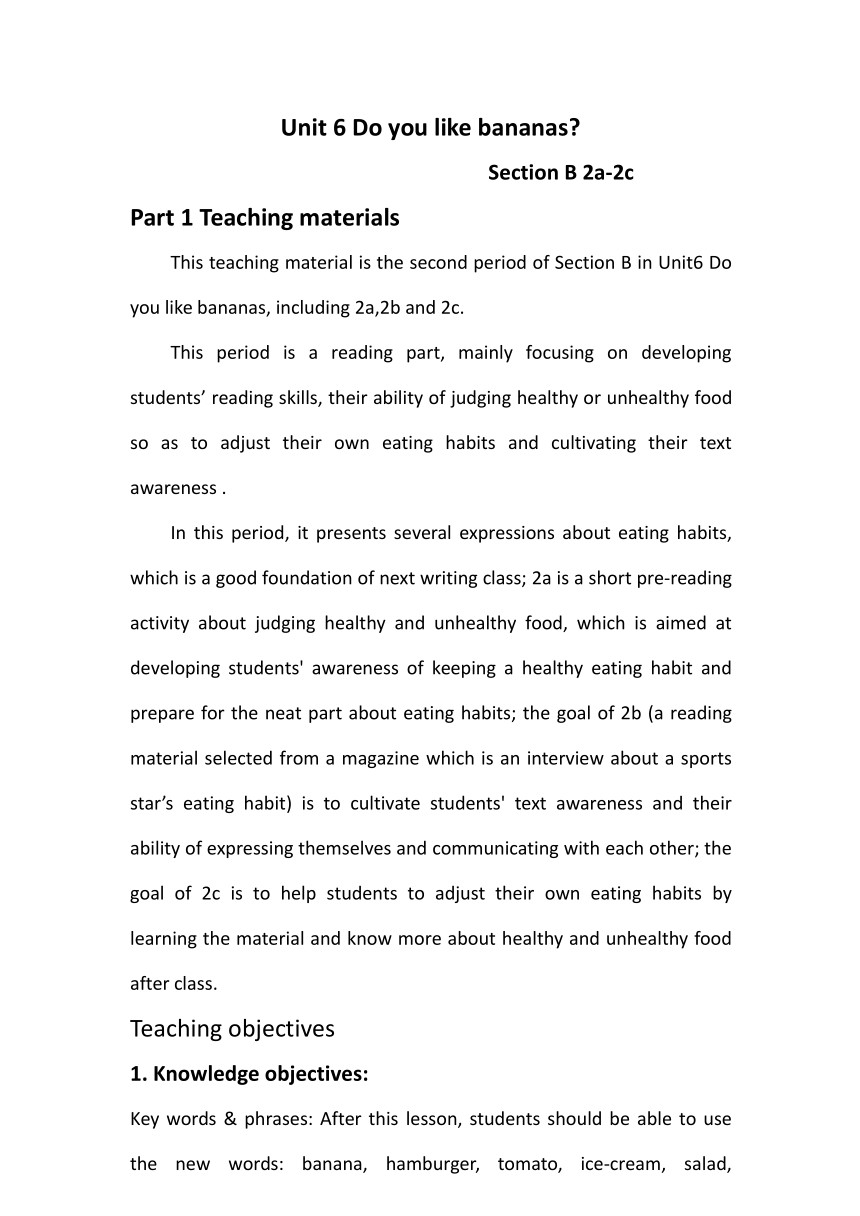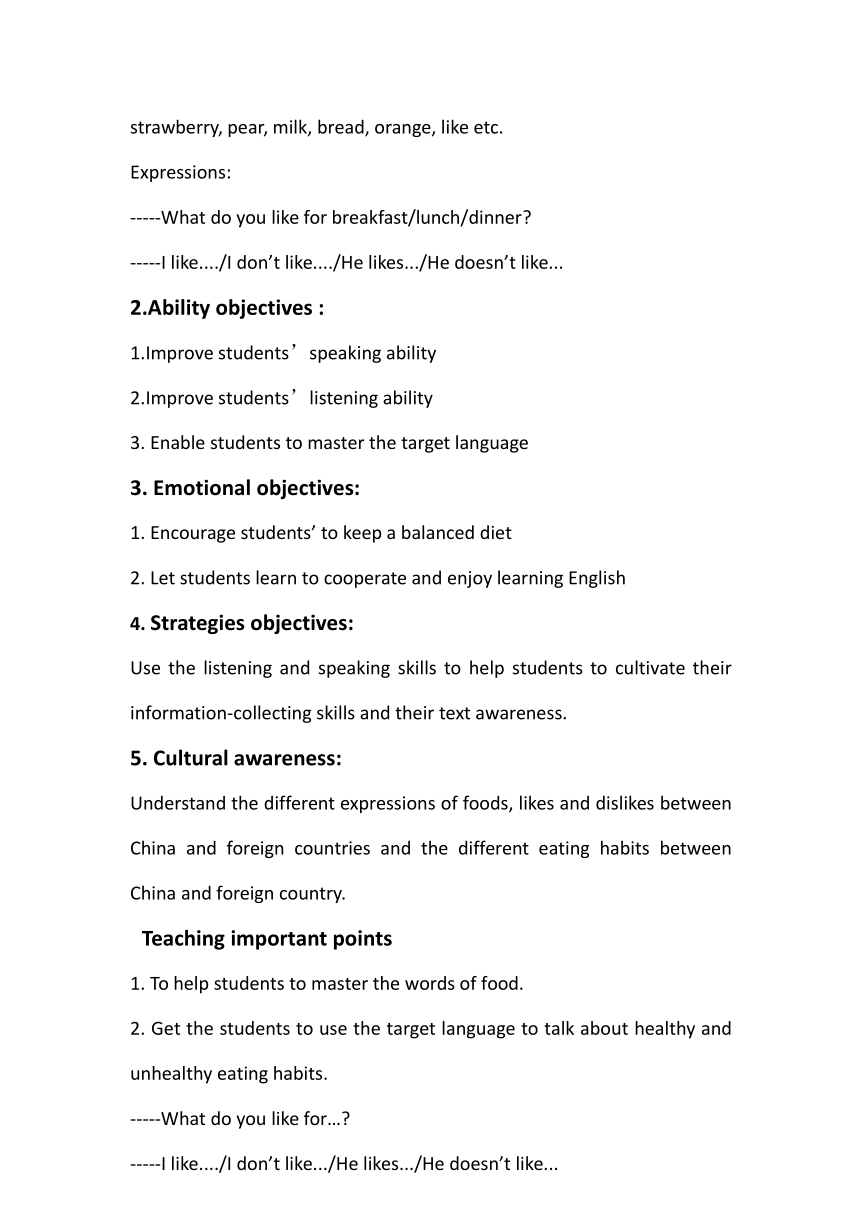Unit 6 Do you like bananas? Section B(2a-2c)教案
文档属性
| 名称 | Unit 6 Do you like bananas? Section B(2a-2c)教案 |  | |
| 格式 | zip | ||
| 文件大小 | 56.0KB | ||
| 资源类型 | 教案 | ||
| 版本资源 | 人教新目标(Go for it)版 | ||
| 科目 | 英语 | ||
| 更新时间 | 2018-11-21 09:39:01 | ||
图片预览



文档简介
Unit 6 Do you like bananas?
Section B 2a-2c
Part 1 Teaching materials
This teaching material is the second period of Section B in Unit6 Do you like bananas, including 2a,2b and 2c.
This period is a reading part, mainly focusing on developing students’ reading skills, their ability of judging healthy or unhealthy food so as to adjust their own eating habits and cultivating their text awareness .
In this period, it presents several expressions about eating habits, which is a good foundation of next writing class; 2a is a short pre-reading activity about judging healthy and unhealthy food, which is aimed at developing students' awareness of keeping a healthy eating habit and prepare for the neat part about eating habits; the goal of 2b (a reading material selected from a magazine which is an interview about a sports star’s eating habit) is to cultivate students' text awareness and their ability of expressing themselves and communicating with each other; the goal of 2c is to help students to adjust their own eating habits by learning the material and know more about healthy and unhealthy food after class.
Teaching objectives
1. Knowledge objectives:
Key words & phrases: After this lesson, students should be able to use the new words: banana, hamburger, tomato, ice-cream, salad, strawberry, pear, milk, bread, orange, like etc.
Expressions:
-----What do you like for breakfast/lunch/dinner?
-----I like..../I don’t like..../He likes.../He doesn’t like...
2.Ability objectives :
1.Improve students’speaking ability
2.Improve students’listening ability
3. Enable students to master the target language
3. Emotional objectives:
1. Encourage students’ to keep a balanced diet
2. Let students learn to cooperate and enjoy learning English
4. Strategies objectives:
Use the listening and speaking skills to help students to cultivate their information-collecting skills and their text awareness.
5. Cultural awareness:
Understand the different expressions of foods, likes and dislikes between China and foreign countries and the different eating habits between China and foreign country.
Teaching important points
1. To help students to master the words of food.
2. Get the students to use the target language to talk about healthy and unhealthy eating habits.
-----What do you like for…?
-----I like..../I don’t like.../He likes.../He doesn’t like...
Teaching difficult points:
To help students to master the target language.
Part 2 Analysis of Students
Students in 7th grade are so active and energetic that they are willing to participate in classroom activities. Before this lesson, the students have learned the expressions of foods and likes and dislikes. And the topic of this part (2a-2c) is about eating habits which students are very interested in. However, students are not so good at judging healthy and unhealthy eating habits. Thus, the teacher should help students to master the key words and phrases, cultivate their awareness of keeping a healthy eating habit through activities, encourage them to search for more information about healthy and unhealthy food to adjust their own habit and prepare for the next class.
Part 3 Teaching methods
1. Situational teaching method
2. Task-based teaching method
3. Communicative and cooperative teaching methods
Part 4 Teaching aids
Multimedia, chart, blackboard, projector and chalks
Part 5 Teaching procedures
I will design the following steps to organize the teaching.
Procedures Teacher’s activities Students’ activities Purpose
Step 1 warm up and lead in (5 mins) Greeting as usualReviewing the new words and phrases that learned in the last class GreetingReview the new words and phrases. Review the and light atmosphere.
Step2 Pre-reading (5 mins) 1. group work2. Help them to fill in the chart, and ask some groups to report.3.Guess the vocation of the women from the picture. Pay attention to the title: Sports Star Eats Well! And try to judge whether she has a healthy eating habit or not in the next reading part. Look at the pictures of these foods. (Show some food pictures.) What kind of food do you think are healthy or unhealthy?? Discuss in groups(four people a group) and fill in the chart. (Each group will have a chart) 4.Help them to pay attention to the style of the material. Help students to know about healthy and unhealthy food,and help them to pay attention to the style of the material.
Step3 While-reading (25mins) 1.Read the first paragraph and answer the following Qs: 1) Who are in this talk? 2) Who is David, who is Cindy? 3) What are they talking about? After reading the first paragraph,try to analyze the style of the material. 3.Read the whole passage and answer the following Qs: 1) How many questions does David ask? 2) What does Cindy eat for breakfast/lunch/dinner? 4. Fill in the chart. Show some pictures like in 1A and ask:Do you think this person has a healthy eating habit? Ask students what do they have for breakfast/lunch/dinner to introduce eating habits. Help them to make a guess about the passage.Help them to analyze the style of the passage. Help them to fill in the chat. 1.Help students to master and use the phrases.2.Help students to know about the characteristics of interview.
Step4 Post-reading (5mins) Finish 2C, make sentences using:sb. likes/doesn’t like Make interviews in groups and try to retell other students’ eating habits. Help students to finish 2C;Help students to know more about healthy and unhealthy food.. Help students to know more about healthy and unhealthy food.
Step5 Summary (5mins) Summary what we learn: words and sentences. Present moral objectives. Summary what we learn: words and sentences Separate healthy food and unhealthy food summary what they learn Learn to keep a healthy eating habit.
Step6 Homework Do a survey of their family about their eating habits and judge whether they are healthy or not.Preview the next part. Preview the next part. Consolidate after class
Part 6 Blackboard design
Unit 6 Do you like bananas? Section B 2a-2c
同课章节目录
- starters 预备篇(2012秋审查)
- Unit 1 Good morning !
- Unit 2 What’s this in English?
- Unit 3 What color is it ?
- Unit 1 My name's Gina.
- Section A
- Section B
- Unit 2 This is my sister.
- Section A
- Section B
- Unit 3 Is this your pencil?
- Section A
- Section B
- Unit 4 Where's my schoolbag?
- Section A
- Section B
- Unit 5 Do you have a soccer ball?
- Section A
- Section B
- Unit 6 Do you like bananas?
- Section A
- Section B
- Unit 7 How much are these socks?
- Section A
- Section B
- Unit 8 When is your birthday?
- Section A
- Section B
- Unit 9 My favorite subject is science.
- Section A
- Section B
